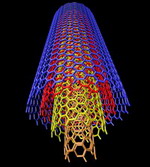Global Carbon Nanotubes Market - SWCNTS, MWCNTS, Technology, Applications, Trends & Outlook (2011 - 2016)
03 Jun 2011 • by Natalie Aster

Wilmington – Consumption of carbon nanotubes is rising at a rapid pace in emerging applications such as electronics and semiconductors, chemicals, batteries and capacitors, fuel cells, medical applications, advanced materials, defense, and many more. Currently, research and development is being undertaken for capturing the new applications; which include glass ceramic, structural steel, agriculture, and hair color for the carbon nanotubes.
The report “Global Carbon Nanotubes Market - SWCNTS, MWCNTS, Technology, Applications, Trends & Outlook (2011 - 2016)” by MarketsandMarkets covers all the commercialized products like SWCNT and MWCNT as well as those expected to be commercialized by 2016. The major geographic markets covered in the report are: North America, Europe, Asia Pacific, and Rest of the world (ROW).
Carbon nanotubes are expensive as compared to the materials with similar properties such as carbon fiber, steel, gold, and copper. The manufacturers also face problems of occupational risks during manufacturing as it requires hazardous processes such as CVD, and Arc discharge. Also, some end users such as wind blades and aerospace components manufacturers witness challenges in terms of translating the nanotubes properties to disperse the nanotubes in composite structures.
Report Details:
Published: April 2011
Pages: 371
Price: US$ 4,650.00
Report Sample Abstract
High demand from current & emerging applications
The carbon nanotubes are being used in solar cells to increase the efficiency of the cells as compared to silicon, and also help to convert sunlight to electricity in efficient ways. The applications include calculators and rooftops. Carbon nanotubes will be replacing silicon transistors in computers also. Silicon is the common material used in semiconductor transistors manufacturing, due its low cost and ease to process. However, replacement of silicon with carbon nanotubes in transistors requires transistors to be made both- smaller and faster than existing versions.
Carbon nanotubes are used in water filtration systems to purify water. The carbon nanotubes help in removal of sediments, chemical effluents, charged particles, bacteria, viruses, spores, and other pathogens from the water purification process. For filtration process, no electricity or chemical reaction is required to purify water. It helps to reduce the cost of purifying water from the oceans and seas. The CNT-enabled water filtration systems capture the emerging applications such as healthcare, emergency and humanitarian response, household use, travel, and the military in advanced industrial and emerging economies.
Cnanoz Inc. (U.S.) developed NanoPure single-treatment water purification system in collaboration with IIT Kanpur (India) using carbon nanotubes in purification process to remove arsenic, fluoride, lead, cadmium, DDT, hydrocarbon wastes, and nitrates for Minister of Rural Water Supply in Andhra Pradesh, India.
Good opportunities in emerging applications
The consumption of composites material is increasing very rapidly in the emerging applications such as aerospace, sporting goods, construction, energy, and marine markets. The use of carbon nanotubes in epoxy material which appears in fiber reinforced plastics helps to increase the strength, and mechanical properties for the finished products. The components also became stiffer, stronger, and lighter with high quality finishing.
Currently, the manufacturers of golf club shaft and sports racquet are using the epoxy/CNT with reinforced material fibers to decrease the product weight while maintaining strength, portability, and flexibility.
The carbon nanotubes have high demand on the commercial level from the emerging applications like lithium batteries, chemical sensors, flat panel displays, hydrogen storage, solar cells, fibers and composites, and so on. The consumption of carbon nanotubes in the emerging applications is expected to increase due to prices coming down and production capacity increasing.
Universities and companies are investing in research and development to come up with new applications for carbon nanotubes materials considering the mechanical, transport, and emerging properties. The future applications include microwave antennas, self-assembling yarns, aerospace (radar absorbing skin), medical implants, drug delivery, fuel filler caps, IC trays, carrier tapes, car body panels, sport goods, coatings, elastomers, and so on.
More information can be found in the report “Global Carbon Nanotubes Market - SWCNTS, MWCNTS, Technology, Applications, Trends & Outlook (2011 - 2016)” by MarketsandMarkets.
To order the report or ask for sample pages contact [email protected]
Contacts
MarketPublishers, Ltd.
Tanya Rezler
Tel: +44 208 144 6009
Fax: +44 207 900 3970
Analytics & News
